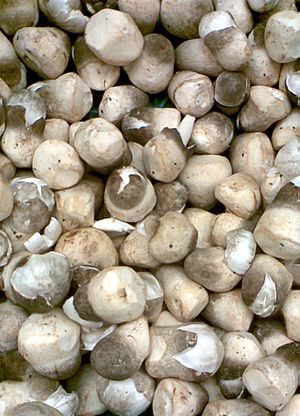Volvariella volvacea facts for kids
Quick facts for kids Volvariella volvacea |
|
|---|---|
 |
|
| Straw mushrooms, some still closed, others open | |
| Scientific classification | |
| Genus: |
Volvariella
|
| Species: |
volvacea
|
| Volvariella volvacea | |
|---|---|
| Mycological characteristics | |
| gills on hymenium | |
| cap is conical or umbonate | |
| hymenium is free | |
| stipe has a volva | |
| spore print is salmon | |
| ecology is saprotrophic | |
| edibility: choice | |
Volvariella volvacea is a type of edible mushroom. It is also called paddy straw mushroom or straw mushroom. People grow this mushroom in East Asia and Southeast Asia. It is used a lot in Asian cooking.
You can often find straw mushrooms fresh in places where they are grown. In other parts of the world, you might find them in cans or dried. These mushrooms are very popular. In fact, straw mushrooms are the third most eaten mushroom around the globe.
Contents
How Straw Mushrooms Grow
Straw mushrooms are grown on beds of rice straw. They are usually picked when they are still young. At this stage, they look like a button or an egg. This is before their outer layer breaks open.
These mushrooms can grow quickly. They take about four to five days to become fully grown. They grow best in warm, wet places. These are called subtropical climates. There are no records of people growing them before the 1800s.
Why Straw Mushrooms Are Good for You
Straw mushrooms are packed with good stuff for your body. Just one cup of these mushrooms has many important nutrients. They give you energy and are a good source of selenium.
They also provide a lot of sodium and iron. You can find copper, vitamin B9 (Folate), and phosphorus in them too. Straw mushrooms also have vitamin B5, protein, and dietary fiber. They even contain zinc, which is good for your health.
How to Identify Straw Mushrooms
When straw mushrooms are young, they can look a bit like a dangerous mushroom called the death cap. But you can tell them apart. One big difference is their spore print.
A spore print is like a mushroom's fingerprint. Straw mushrooms have a pink spore print. Death caps, however, have a white spore print.
Also, these two mushrooms usually grow in different places. Death caps are not often found where straw mushrooms naturally grow. But it is always important to be careful when picking wild mushrooms. Make sure you know exactly what you are eating.
See also
 In Spanish: Seta paja de arroz para niños
In Spanish: Seta paja de arroz para niños

